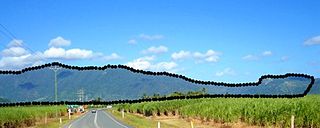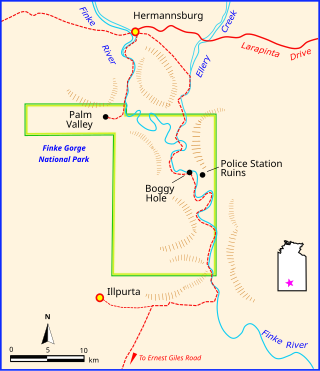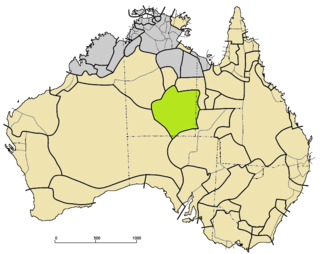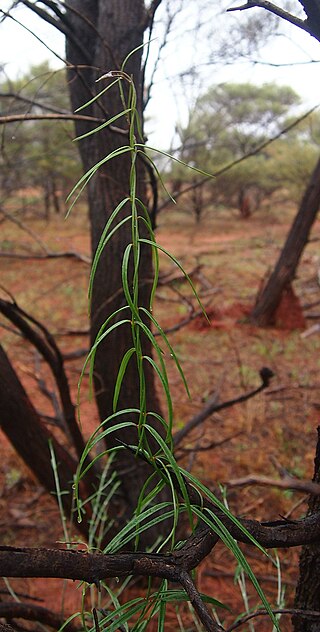
Australian Aboriginal religion and mythology is the sacred spirituality represented in the stories performed by Aboriginal Australians within each of the language groups across Australia in their ceremonies. Aboriginal spirituality includes the Dreamtime, songlines, and Aboriginal oral literature.

The Dreaming, also referred to as Dreamtime, is a term devised by early anthropologists to refer to a religio-cultural worldview attributed to Australian Aboriginal beliefs. It was originally used by Francis Gillen, quickly adopted by his colleague Sir Baldwin Spencer and thereafter popularised by A. P. Elkin, who, however, later revised his views.
In Arrernte mythology, Karora is a bandicoot ancestral deity. According to one legend, during the Dreamtime Karora lay sleeping in the earth when from his head rose a tall pole called a tnatantja. It was a living creature, its bottom resting on his head and its top reaching up into the sky. From his armpits and navel emerged bandicoots, who dug their way out of the earth just as the first sun rose into the sky. Karora followed them, seized two of the animals, then cooked and ate them. His hunger sated, he lay down to sleep again and a bullroarer emerged from under his armpit. It took on human form and grew into a young man, and when Karora woke his son danced around him. It was the very first ceremony.
In Arrernte religion and mythology, Mangar-kunjer-kunja is a lizard Ancestral Being who created humans. He found the first aboriginal beings, Rella manerinja, on one side of a hill; they were fused together and he separated them with a knife and cut holes for their mouths, ears and noses, then gave them the knife, spear, shield, fire, boomerang and the tjurunga, and lastly gave them a system of marriage.

Finke Gorge National Park is a protected area in the Northern Territory of Australia located about 1,318 kilometres (819 mi) south of the territory capital of Darwin. The national park covers an area of 458 km2 (177 sq mi), and includes the desert oasis Palm Valley, home to a diverse range of plant species, many of which are rare and unique to the area. There are good opportunities for bushwalking and bushcamping in the national park.

The Rainbow Serpent or Rainbow Snake is a common deity often seen as the creator God, known by numerous names in different Australian Aboriginal languages by the many different Aboriginal peoples. It is a common motif in the art and religion of many Aboriginal Australian peoples. Much like the archetypal mother goddess, the Rainbow Serpent creates land and diversity for the Aboriginal people, but when disturbed can bring great chaos.
Theodor George Henry Strehlow was an Australian anthropologist and linguist. He notably studied the Arrernte Aboriginal Australians and their language in Central Australia.
The Hermannsburg School is an art movement, or art style, which began at the Hermannsburg Mission in the 1930s. The best known artist of the style is Albert Namatjira. The movement is characterised by watercolours of western-style landscapes that depict the often striking colours of the Australian outback.

Arrernte or Aranda, or sometimes referred to as Upper Arrernte, is a dialect cluster in the Arandic language group spoken in parts of the Northern Territory, Australia, by the Arrernte people. Other spelling variations are Arunta or Arrarnta, and all of the dialects have multiple other names.

The Arrerntepeople, sometimes referred to as the Aranda, Arunta or Arrarnta, are a group of Aboriginal Australian peoples who live in the Arrernte lands, at Mparntwe and surrounding areas of the Central Australia region of the Northern Territory. Many still speak one of the various Arrernte dialects. Some Arrernte live in other areas far from their homeland, including the major Australian cities and overseas.

A kurdaitcha, or kurdaitcha man, also spelt gadaidja, cadiche, kadaitcha, karadji, or kaditcha, is a type of shaman and traditional executioner amongst the Arrernte people, an Aboriginal group in Central Australia. The name featherfoot is used to denote the same figure by other Aboriginal peoples.
Australian Aboriginal culture includes a number of practices and ceremonies centered on a belief in the Dreamtime and other mythology. Reverence and respect for the land and oral traditions are emphasised. Over 300 languages and other groupings have developed a wide range of individual cultures. Due the colonization of Australia under terra nullius concept these cultures were treated as one monoculture. Australian Aboriginal art has existed for thousands of years and ranges from ancient rock art to modern watercolour landscapes. Aboriginal music has developed a number of unique instruments. Contemporary Australian Aboriginal music spans many genres. Aboriginal peoples did not develop a system of writing before colonisation, but there was a huge variety of languages, including sign languages.

Leichhardtia australis, commonly known as the bush banana, silky pear or green vine is an Australian native plant. It is found in Central Australia and throughout Western Australia. It is a bush tucker food used by Indigenous Australians.
In Australian Aboriginal art, a Dreaming is a totemistic design or artwork, which can be owned by a tribal group or individual. This usage of anthropologist W. E. H. Stanner's term was popularised by Geoffrey Bardon in the context of the Papunya Tula artist collective he established in the 1970s.

Arandic is a family of Australian Aboriginal languages consisting of several languages or dialect clusters, including the Arrernte group, Lower Arrernte, Pertame language and Kaytetye.
Wambeen is an evil god of Australian Aboriginal mythology, specifically that of the Arrernte people. Known for his lightning hurling figure, like many other subjects of ancient tales, Wambeen prefers travelers for his victims. Said to come down to earth to smite wanderers, he was recognized only by his smell of evil.

Barnumbirr, also known as Banumbirr or Morning Star, is a creator-spirit in the Yolngu culture of Arnhem Land in the Northern Territory of Australia, who is identified as the planet Venus. In Yolngu Dreaming mythology, she is believed to have guided the first humans, the Djanggawul sisters, to Australia. After the Djanggawul sisters arrived safely near Yirrkala in North East Arnhem Land, Barnumbirr flew across the land from east to west, creating a songline which named and created the animals, plants, and geographical features.
Arrernte Sign Language, or Aranda Sign Language, also known as Iltyeme-iltyeme (handsigns), is a highly developed Australian Aboriginal sign language used by the Arrernte people of central Australia.








